Mises, Ludwig von. Human Action: A Treatise on Economics
Подождите немного. Документ загружается.

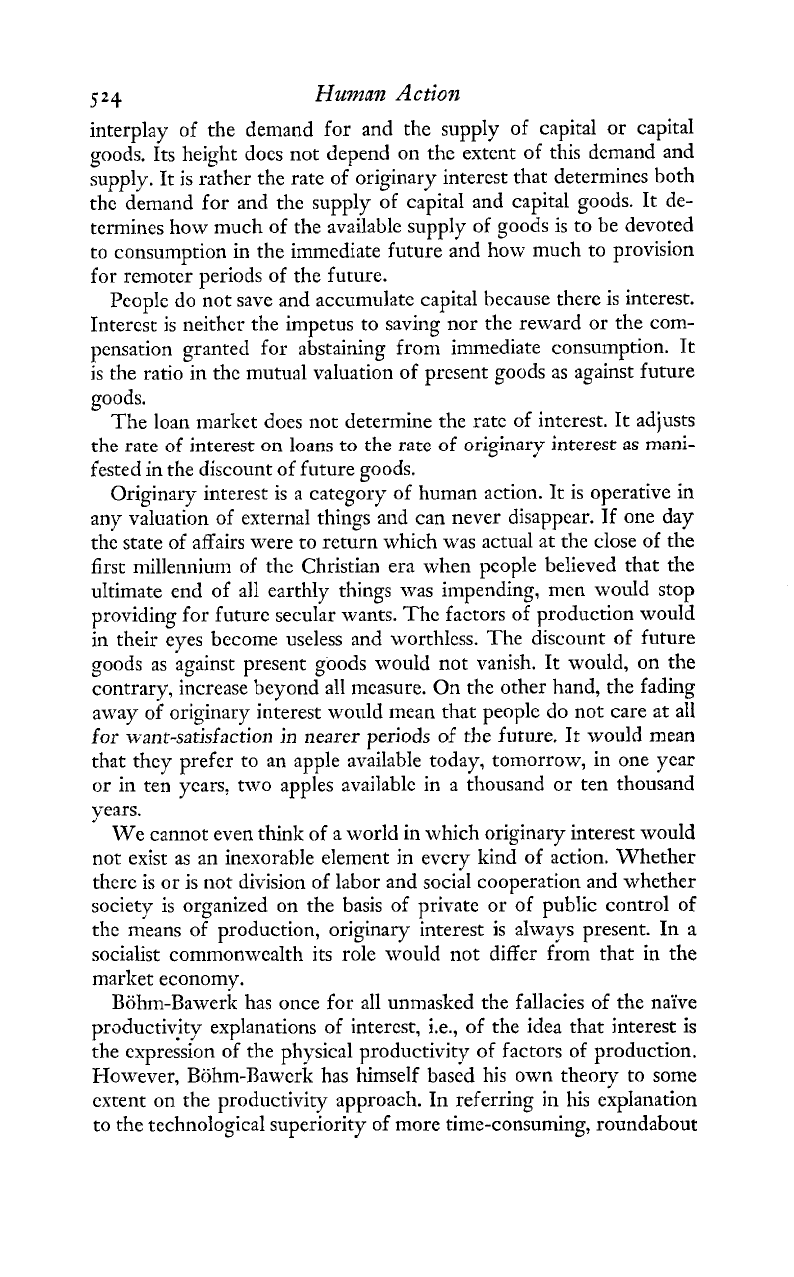
524
Human
Action
interplay of the denland for and the suppIy of capital or capital
goods. Its height docs not depend on the extent of this dcmand and
supply. It is rather the rate of originary interest that determines both
the demand for and the supply of capital and capital goods. It de-
termines how much of the available supply of goods is to be devoted
to consumption in the immediate future and how much to provision
for remoter periods of the future.
People do not save and accumulate capital because there is interest.
Interest is neither the impetus to saving nor the reward or the com-
pensation granted for abstaining from immediate consumption. It
is the ratio in the mutual valuation of present goods as against future
goods.
The loan market does not determine the rate of interest. It adjusts
the rate of interest on loans to the rate of originary interest as mani-
fested in the discount of future goods.
Originary interest is a category of human action. It is operative in
any valuation of external things and can never disappear. If one day
the state of affairs were to return which was actual at the close of the
first millennium of the Christian era when people believed that the
uItimate end of all earthly things mas impending, mcn would stop
providing for future secular wants. The factors of production would
in their eyes bccome useless and worthlcss. The discount of future
goods as against present goods would not vanish. It would, on the
contrary, increase beyond all measure. On the other hand, the fading
away of originary interest would mean that people do not care at a11
for want-satisfaction
in
nearer periods of the future. It would mean
that they prefer to an apple available today, tomorrow, in one year
or in ten years, two apples available in a thousand or ten thousand
years.
We
cannot even think of
a
world in which originary interest would
not exist as an inexorable element in every kind of action. Whether
there is or is not division of labor and social cooperation and whether
society is organized on the basis of private or of public control of
the means of production, originary interest is always present. In a
socialist commonwealth its role would not differ from that in the
market economy.
~iihrn-~awerk has once for all unmasked the fallacies of the nai've
productivjty explanations of interest, ie., of the idea that interest
is
the expression of the physical productivity of factors of production.
However, Biihm-Bawcrk has himself based his own theory to some
extent on the productivity approach. In referring in his explanation
to the technological superiority of more time-consuming, roundabout
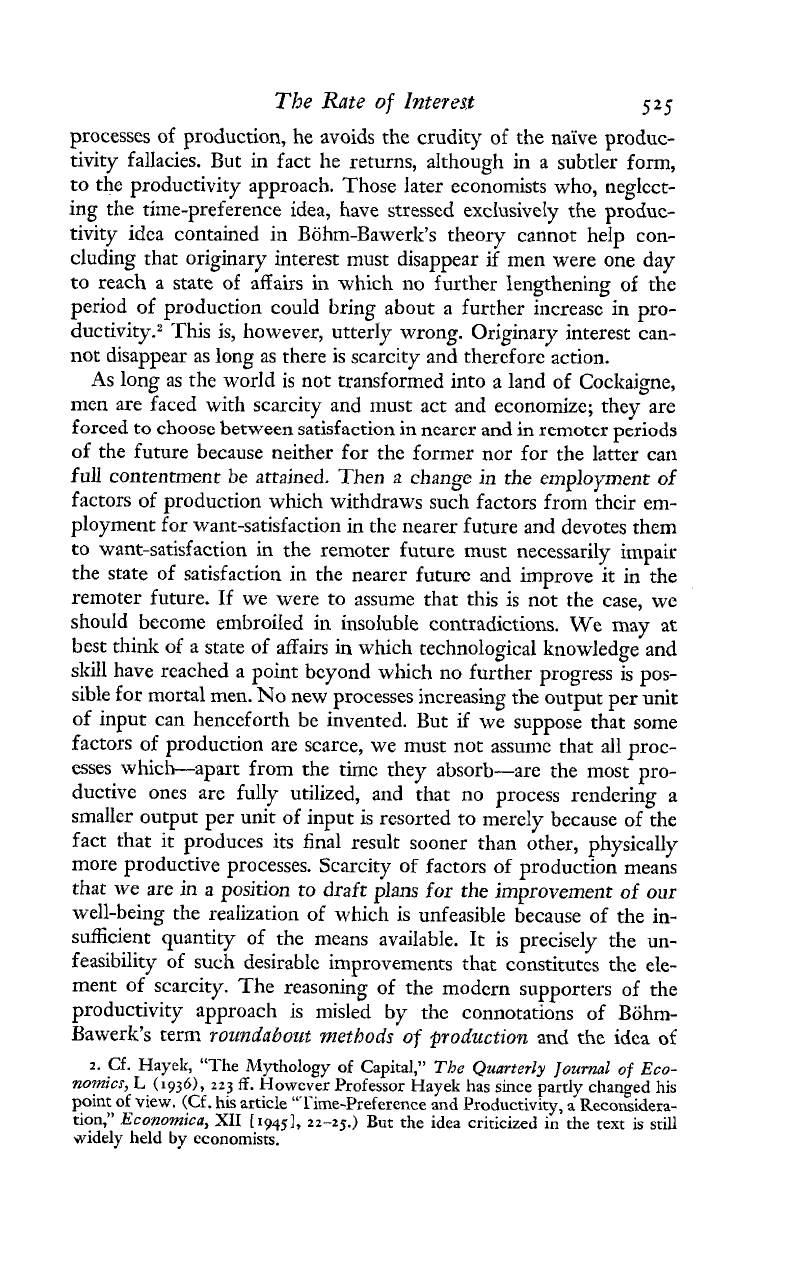
The
Rate
of
Internt
processes of production, he avoids the crudity of the naive produc-
tivity fallacies. But in fact he returns, although in a subtler form,
to the productivity approach. Those later economists who, neglect-
ing the tinie-preference idea, have stressed excIusively the produc-
tivity idea contained in Bohm-Bawerk's theory cannot help con-
cluding that originary interest must disappear if men were one day
to reach
a
state of affairs
in
which no further lengthening of the
period of production could bring about a further increase in pro-
ductivity."This is, however, utterly wrong. Originary interest can-
not disappear as long as there is scarcity and therefore action.
As long as the world is not transformed into a land of Cockaigne,
men are faced with scarcity and must act and economize; they arc
forced to choose between satisfaction in ncarcr and in remoter periods
of the future because neither for the former nor for the latter can
full
contentment be attained. Then
a
change
in
the eznployment
of
factors of production which withdraws such factors from their em-
ployment for want-satisfaction in the nearer future and devotes them
to want-satisfaction in the remoter future must necessarily impair
the state of satisfaction in the nearer future and improve it in the
remoter future. If we were to assume that this is not the case, we
should become embroiIed in insoiuble contradictions. We
may
at
best think of a state of affairs in which technological knowledge and
skill have reached a point beyond which no further progress is pos-
sible for mortal men. No new processes increasing the output per unit
of input can henceforth be invented. But if we suppose that some
factors of production are scarce, we must not assunlc that all proc-
esses which-apart from the timc they absorb-are the most pro-
ductive ones are fully utilized, and that no process rendering a
smaller output per unit of input is resorted to merely because of the
fact that it produces its final result sooner than other, physically
more productive processes. Scarcity of factors of production means
that we are
in
a position to draft plans for the improvement of
our
well-being the realization of which is unfeasible because of the in-
sufficient quantity of the means available. It is precisely the un-
feasibility of such desirable improvements that constitutes the ele-
ment of scarcity. The reasoning of the modern supporters of the
productivity approach is misled by the connotations of B6hm-
Bawerk's term
roundabout
method$
of
production
and
the
idea
of
2.
Cf. Hayek, "The Mythology of Capital,"
The
Quarterly
Iournal
of
Eco-
nomics,
L
(igj6),
223
ff.
Howcver Professor Hayek has since partly changed
his
point of view. (Cf.
his
article 'Time-Preference and Productivity,
a
Reconsidera-
tion,"
Economics,
XI1
[
19451, 22-25.)
But the idea criticized
in
the text
is
still
widely held
by
cconornists.
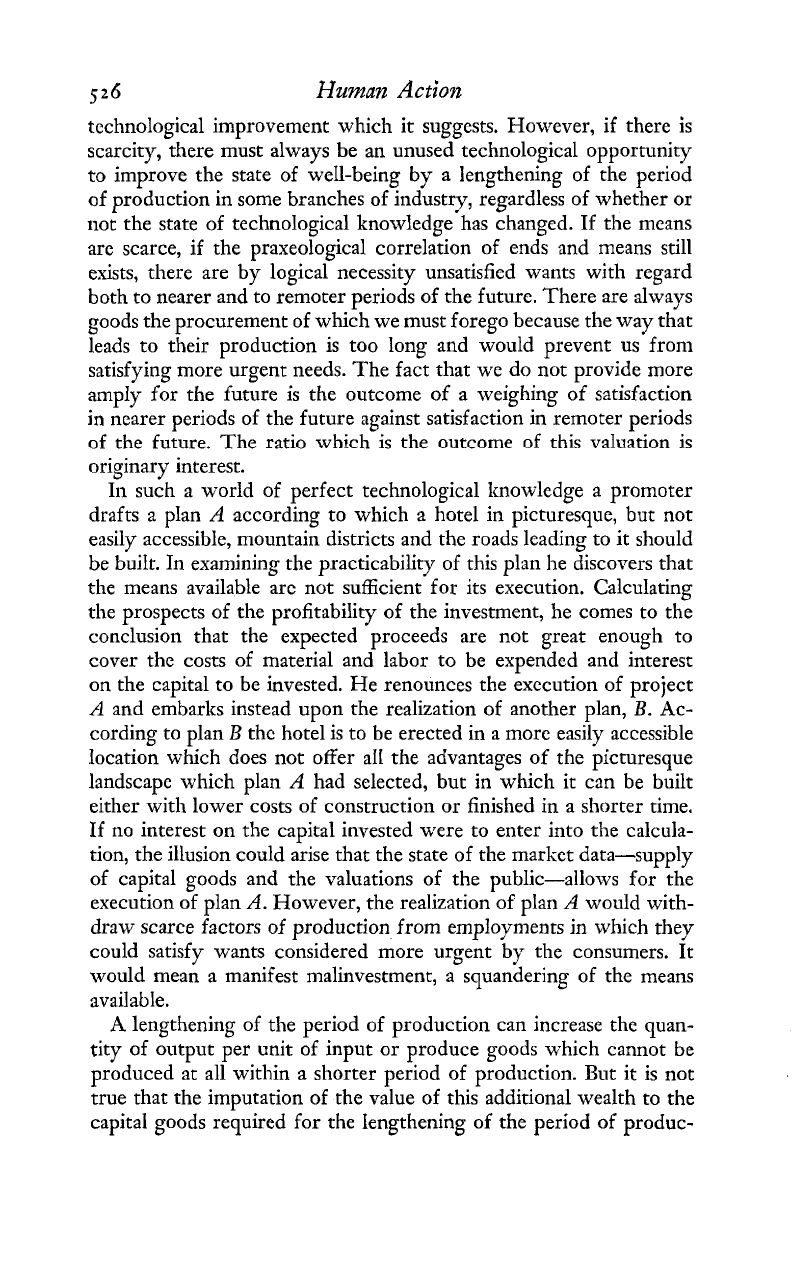
526
Human
Action
technological improvement which it suggests. However, if there is
scarcity, there must always be an unused technological opportunity
to improve the state of well-being by a lengthening of the period
of production in some branches of industry, regardless of whether or
not the state of technological knowledge has changed. If the means
are scarce, if the praxeological correlation of ends and means still
exists, there are by logical necessity unsatisfied wants with regard
both to nearer and to remoter periods of the future. There are always
goods the procurement of which we must forego because the way that
leads to their production is too long and would prevent us from
satisfying more urgent needs. The fact that we do not provide more
amply for the future is the outcome of a weighing of satisfaction
in
nearer periods of the future against satisfaction in remoter periods
of the future. The ratio which is the outcome of this valuation is
originary interest.
In
such a world of perfect technological knowledge a promoter
drafts a plan
A
according to which a hotel in picturesque,
but
not
easily accessible, mountain districts and the roads leading to it should
be buiIt. In examining the practicability of this plan he discovers that
the means available are not sufficient for its execution. Calculating
the prospects of the profitability of the investment, he comes to the
conclusion that the expected proceeds are not great enough to
cover the costs of material and labor to be expended and interest
on the capital to be invested. He renounces the execution of project
A
and embarks instead upon the realization of another plan,
B.
Ac-
cording to plan
B
the hotel is to be erected in a more easily accessible
location which does not offer a11 the advantages of the picturesque
landscape which plan
A
had selected, but in which it can be built
either with lower costs of construction or finished in a shorter time.
If no interest on the capital invested were to enter into the calcula-
tion, the illusion could arise that the state of the market data-supply
of capital goods and the valuations of the public-allows for the
execution of plan
A.
However, the realization of plan
A
would with-
draw scarce factors of production from employments in which they
could satisfy wants considered more urgent by the consumers. It
would mean a manifest malinvestment, a squandering of the means
available.
A
lengthening of the period of production can increase the quan-
tity of output per unit of input or produce goods which cannot be
produced at all within a shorter period of production. But it is not
true that the imputation of the value of this additional wealth to the
capital goods required for the Iengthening of the period of produc-
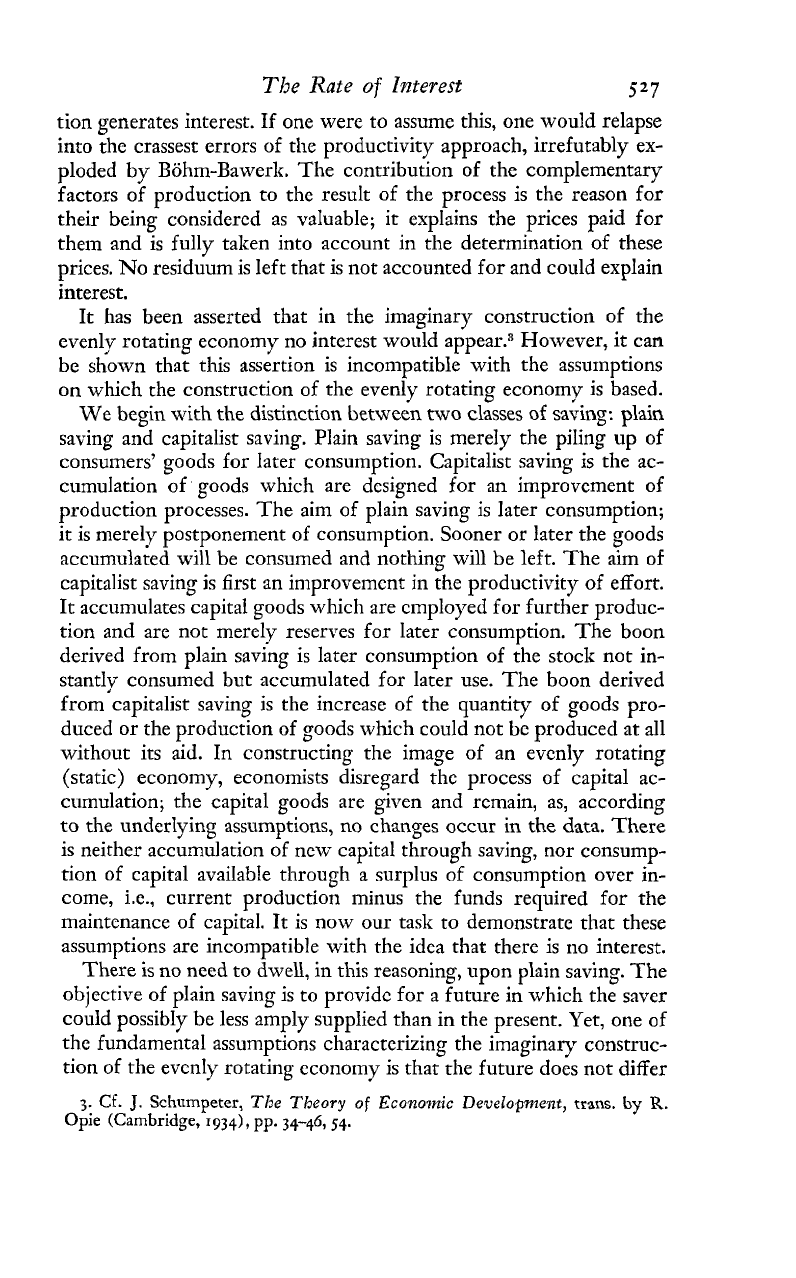
The
Rate
of
Interest
527
tion generates interest. If one were to assume this, one would relapse
into the crassest errors of the productivity approach, irrefutably ex-
ploded by Bohm-Bawerlr. The contribution of the complementary
factors of production to the result of the process is the reason for
their being considered as valuable; it explains the prices paid for
them and is fully taken into account in the determination of these
prices. No residuum is left that is not accounted for and could explain
interest.
It has been asserted that in the imaginary construction of the
evenly rotating economy no interest would appear.Wowever, it can
be shown that this assertion is incompatible with the assu~nptions
on which the construction of the evenly rotating economy is based.
We begin with the distinction between
two
classes
of
saving: plain
saving and capitalist saving. Plain saving is merely the piling up of
consumers' goods for later consumption. Capitalist saving is the ac-
cumulation of goods which are designed for an improvement of
production processes. The aim of plain saving is later consumption;
it is merely postponement of consumption. Sooner or later the goods
accumula;ed
will
be consumed and nothing will be left. The aim of
capitalist saving is first an improvement in the productivity of effort.
It accumulates capital goods which are cmploped for further produc-
tion and are not merely reserves for later consumption. The boon
derived from plain saving is later consumption of the stock not in-
stantly consumed but accumulated for later use. The boon derived
from capitalist saving is the increase of the quantity of goods pro-
duced or the production of goods which could not be produced at all
without its aid. In constructing the image of an evcnly rotating
(static) economy, economists disregard the process of capital ac-
cumulation; the capital goods are given and remain, as, according
to the underlying assumptions, no changes occur
in
the
data.
There
is neither accumulation of new capital through saving, nor consump-
tion of capital availabIe through a surplus of consumption over in-
come, k., current production minus the funds required for the
maintcnance of capital. It is now our task to demonstrate that these
assumptions are incompatible with the idea that there is no interest.
There is no need to dwell, in this reasoning, upon plain saving. The
objective of plain saving is to provide for a future in which the saver
could possibly be less amply supplied than in the present. Yet, one of
the fundamental assumptions characterizing the imaginary construc-
tion of the evcnly rotating economy is that the future does not differ
3.
Cf.
J.
Schumpeter,
The
Theory of Econowzic Development,
trans.
by
£2.
Opie
(Cambridge,
19341,
pp.
34-46,
54.
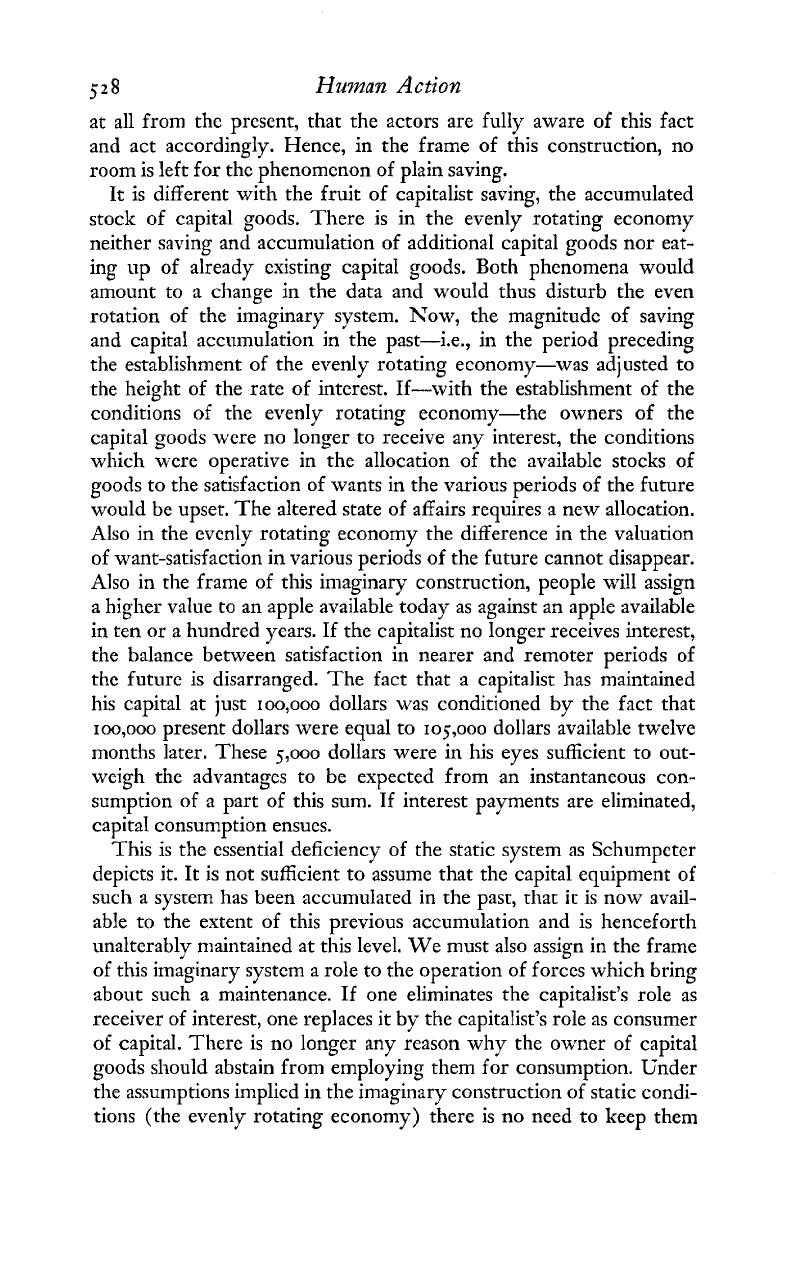
j28
Human
Action
at all from the present, that the actors are fully aware of this fact
and act accordingly. Hence, in the frame of this construction, no
room is left for the phenomenon of plain saving.
It is different with the fruit of capitalist saving, the accumulated
stock of capital goods. There is in the evenly rotating economy
neither saving and accumulation of additional capital goods nor eat-
ing up of already existing capita1 goods. Both phenomena would
amount to a change in the data and would thus disturb the even
rotation of the imaginary system. hTow, the magnitude of saving
and capital accumulation in the past-i.e., in the period preceding
the establishment of the evenly rotating economy-was adjusted to
the height of the rate of interest. If-with the estabIishment of the
conditions of the evenly rotating economy-the owners of the
capital goods were no longer to receive any interest, the conditions
which were operative in the allocation of the available stocks of
goods to the satisfaction of wants in the various periods of the future
would be upset. The altered state of affairs requires a new allocation.
Also in the evenly rotating economy the difference in the valuation
of want-satisfaction in various periods of the future cannot disappear.
Also in the frame of this imaginary construction, people will assign
a
higher value to an apple available today as against an apple available
in ten or a hundred years. If the capitalist no longer receives interest,
the balance between satisfaction in nearer and remoter periods of
the future is disarranged. The fact that a capitalist has maintained
his capital at just ~oo,ooo dollars was conditioned by the fact that
~oo,ooo present dollars were equal to 105,ooo dollars available twelve
months later. These 5,000 dollars were in his eyes sufficient to out-
weigh the advantages to be expected from an instantaneous con-
sumption of a part of this sum. If interest payments are eliminated,
capital consumption ensues.
This is the essential deficiency of the static system as Schumpeter
depicts it. It is not sufficient to assume that the capital equipment of
such a system has been accumuiated in the past, that it is now avaii-
able to the extent of this previous accumulation and is henceforth
unalterably maintained at this level. We must also assign in the frame
of this imaginary system a role to the operation of forces which bring
about such a maintenance. If one eliminates the capitalist's role as
receiver of interest, one replaces it by the capitalist's role as consumer
of capital. There is no longer any reason why the owner of capital
goods should abstain from employing them for consumption. Under
the assumptions implied in the imaginary construction of static condi-
tions (the evenly rotating economy) there is no need to keep them
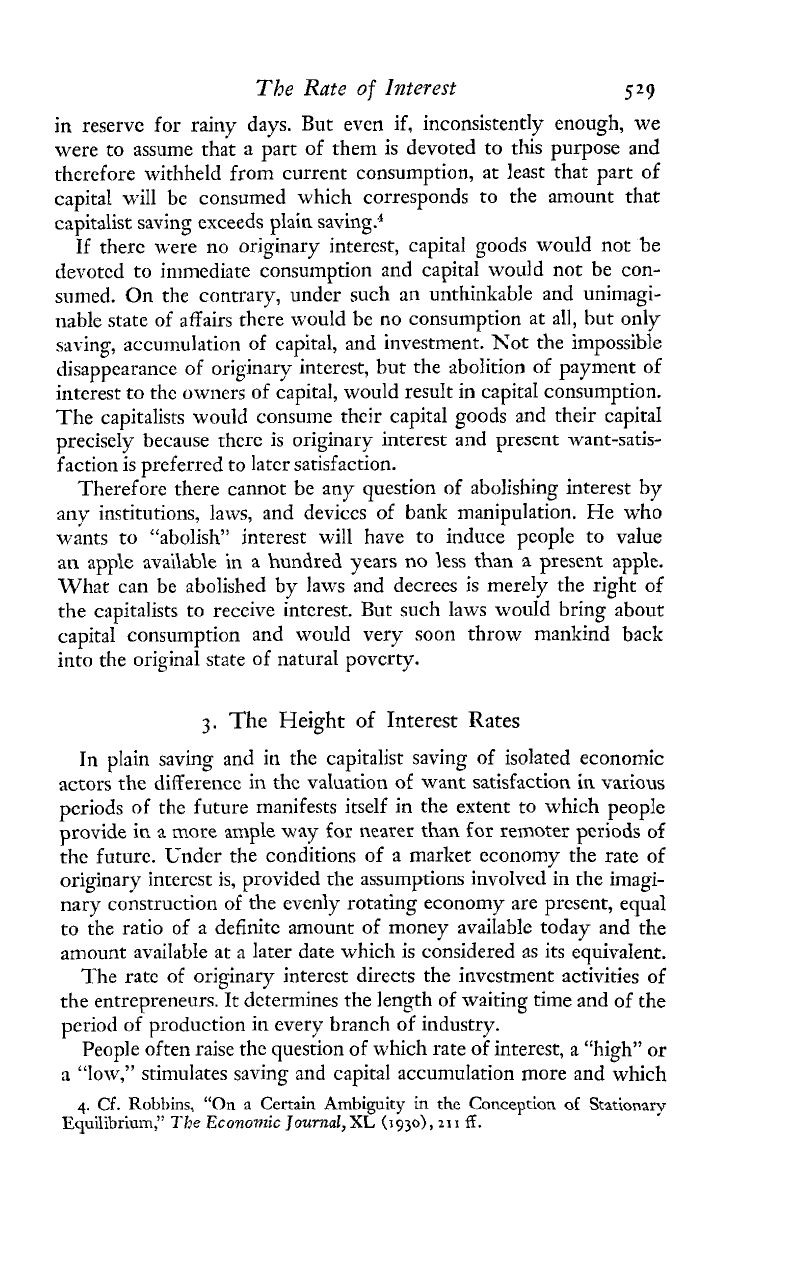
The Rate
of
Interest
529
in reserve for rainy days. But even if, inconsistently enough, we
were to assume that a part of them is devoted to this purpose and
therefore withheld from current consumption, at least that part of
capital will be consumed which corresponds to the amount that
capitalist saving exceeds plain saving.'
If
there were no originary interest, capital goods would not be
devoted to in~mediate consumption and capital would not be con-
sumed. On the contrary, under such an unthinkable and unimagi-
nable state of affairs there would be no consumption at all, but only
saving, accumulation of capital, and investment. Not the impossible
disappearance of originary intercst, but the abolition of payment of
interest to the owncrs of capital, would resuIt in capital consumption.
The capitalists would consume their capital goods and their capita1
preciseIy because there is originary interest and present want-satis-
faction is preferred to later satisfaction.
Therefore there cannot be any question of abolishing interest
by
any institutions, laws, and devices of bank manipulation. He who
wants to "abolish" interest will have to induce people to value
an apple available in a hundred years
no
less
than
a
present apple.
What can be abolished by laws and decrees is merely the right of
the capitalists to receive interest. But such laws would bring about
capital consumption and would very soon throw mankind back
into the original state of natural poverty.
3.
The Height of Interest Rates
In plain saving and in the capitalist saving of isolated economic
actors the difference in thc valuation
of
want satisfaction
in
various
p-iods of the future manifests itself in the extent to which people
pavide in
a more ample
way
for
nearer
than
for
remoter periods
of
the future. Under the conditions of a market economy the rate of
originary intercst
is,
provided the assumptions involved in the imagi-
nary construction of the evenly rotating economy are present, equal
to the ratio of a definite amount of money available today and the
amount availabk at a later date which is considered as its equivaknt.
The ratc of originary interest directs the investment activities of
the entrepreneurs. It determines the length of waiting time and of the
period of production in every branch of industry.
People often raise the question of which rate of interest, a "high" or
a
"low," stimulates saving and capital accumulation more and which
4.
Cf.
Robbins,
"On
a
Certain
Ambiguity
in
the
Conception
of
Stationary
Equilibrium,"
The
Economic
Journal,
XL
(193o),
21
I
ff.
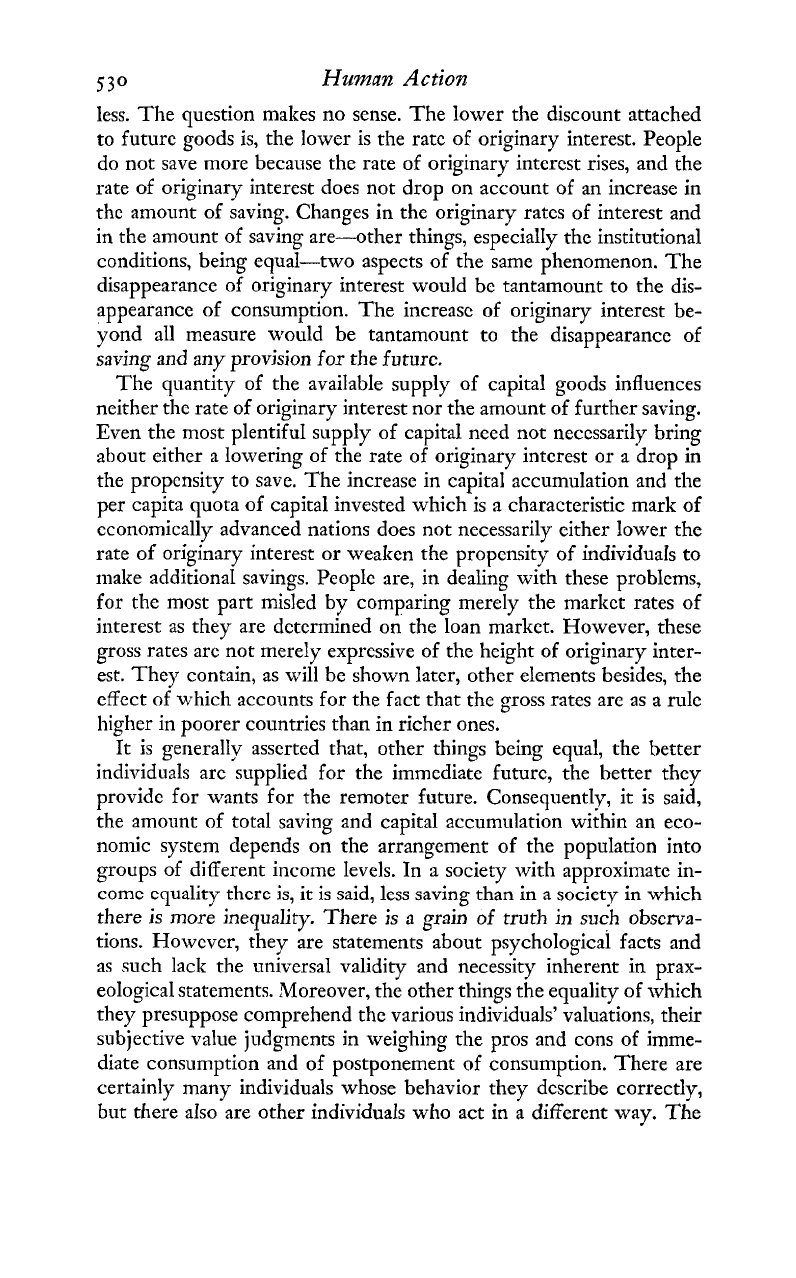
530
Human
Action
less. The question makes no sense. The lower the discount attached
to future goods is, the lower is the rate of originary interest. People
do not save more because the rate of originary intcrcst rises, and the
rate of originary interest does not drop on account of an increase in
the amount of saving. Changes in the originary rates of interest and
in the amount of saving are-other things, especially the institutional
conditions, being equal-two aspects of the same phenomenon. The
disappearance of originary interest would be tantamount to the dis-
appearance of consumption. The increase of originary interest be-
yond all measure would be tantamount to the disappearance of
saving and any provision for the future.
The quantity of the available supply of capital goods influences
neither the rate of originary interest nor the amount of further saving.
Even the most plentifuI supply of capital need not neccssarily bring
about either a lowering of the rate of originary intcrcst or a drop in
the propensity to save. The increase in capital accumulation and the
per capita quota of capital invested which is a characteristic mark of
economically advanced nations does not necessarily either lower the
rate of originary interest or weaken the propensity of individuaIs to
make additiona1 savings. PeopIe are, in dealing with these problems,
for the most part misled by comparing merely the market rates of
interest as they are determined on the loan market. However, these
gross rates arc not merely expressive of the height of originary inter-
est. They contain, as will be shown later, other elements besides, the
effect of which accounts for the fact that the gross rates are as a rule
higher in poorer countries than in richer ones.
It is generally asserted that, other things being equal, the better
individuals are supplied for the immediate future, the better they
provide for wants for the rernotcr future. Consequently, it is said,
the amount of total saving and capital accumulation wifhin an eco-
nomic system depends on the arrangement of the population into
groups of different income levels. In a society with approximate in-
come equality there is, it is said, less saving than in a society in which
there
is
more inequality. There is a gr.rain of truth
in
sudh obscrva-
tions. However, they are statements about psychological facts and
as such lack the universal validity and necessity inherent in prax-
eological statements. Moreover, the other things the equality of which
they presuppose comprehend the various individuals' valuations, their
subjective value judgments in weighing the pros and cons of imme-
diate consumption and of postponement of consumption. There are
certainly many individuals whose behavior they describe correctly,
but there also are other individuals who act in a different way. The
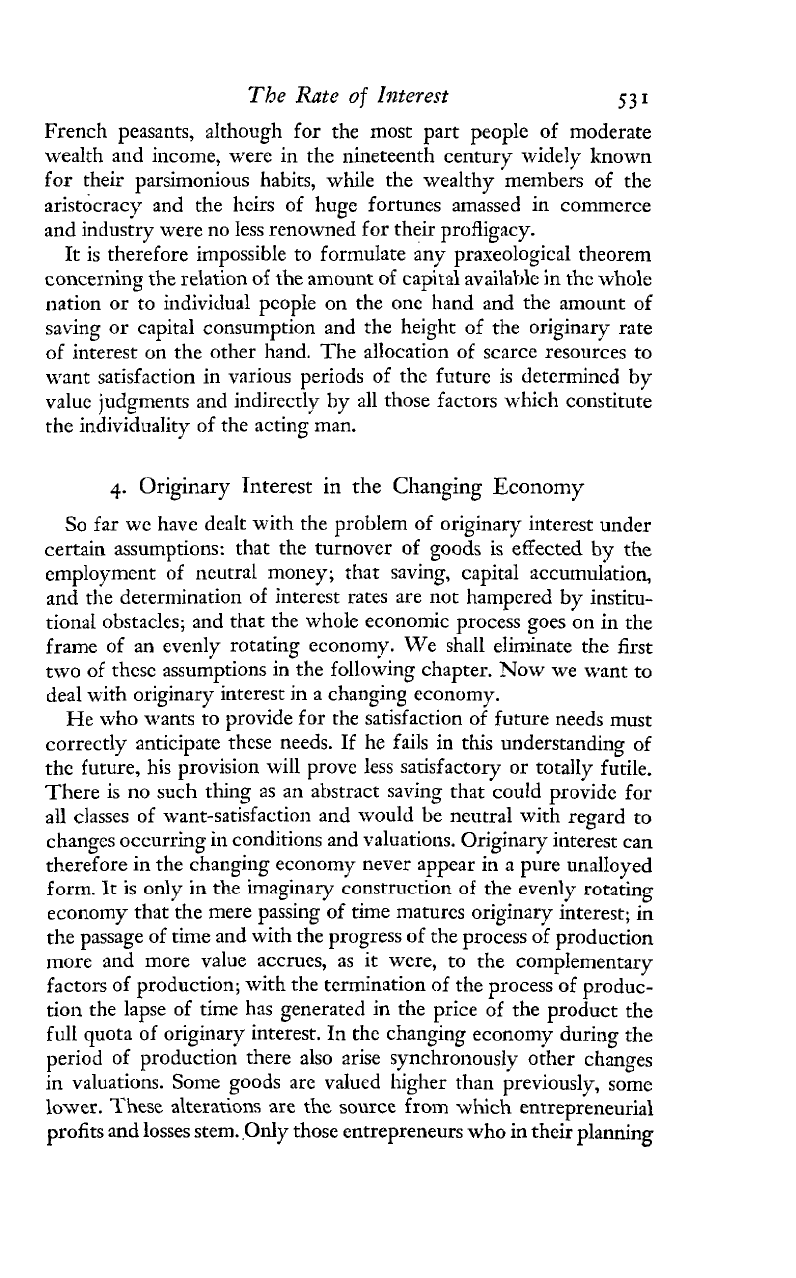
The
fire
of
Interest
531
French peasants, although for the most part people of moderate
wealth and income, were in the nineteenth century widely known
for their parsimonious habits, while the wealthy members of the
aristocracy and the heirs of huge fortunes amassed in commerce
and industry were no Iess renowned for their profligacy.
It is therefore impossible to formulate any praxeological theorem
concerning the relation of the amount of capital available
in
the
whole
nation or to individual people on the one hand and the amount of
saving or capital consumption and the height of the originary rate
of interest on the other hand. The allocation of scarce resources to
want satisfaction in various periods of the future is determined by
value judgments and indirectly hy all those factors which constitute
the individuality of the acting man.
4.
Originary Interest in the Changing Economy
So far we have dealt with the problem of originary interest under
certain assumptions: that the turnover of goods is effected by the
employment of neutral money; that saving, capital accurnuiation,
and the determination of interest rates are not hampered by institu-
tionaI obstacles; and that the whole economic process goes on in the
frame of an evenly rotating economy. We shall eliminate the first
two of thcsc assumptions in the following chapter. Now we want to
deal with originary interest in a changing economy.
He
who wants to provide for the satisfaction of future needs must
correctly anticipate these needs. If he fails in this understanding of
the future, his provision will prove less satisfactory or totalIy futile.
There is no such thing as an abstract saving that could provide for
all classes of want-satisfaction and would be neutral with regard to
changes occurring in conditions and valuations. Originary interest can
therefore in the changing economy never appear in a pure unalloyed
form. It is only in
the
imaginary construction of the evenly rotating
economy that the mere passing of time matures originary interest; in
the passage of time and with the progress of the process of production
Inore and more value accrues, as it were, to the complementary
factors of production; with the termination of the process of produc-
tion the lapse of time has generated in the price of the product the
full quota of originary interest. In the changing economy during the
period of production there also arise synchronously other changes
in valuations. Some goods are valued higher than previously, some
lower.
These
alterations are the source from
which
entrepreneurial
profits and losses stem. Only those entrepreneurs who in their planning
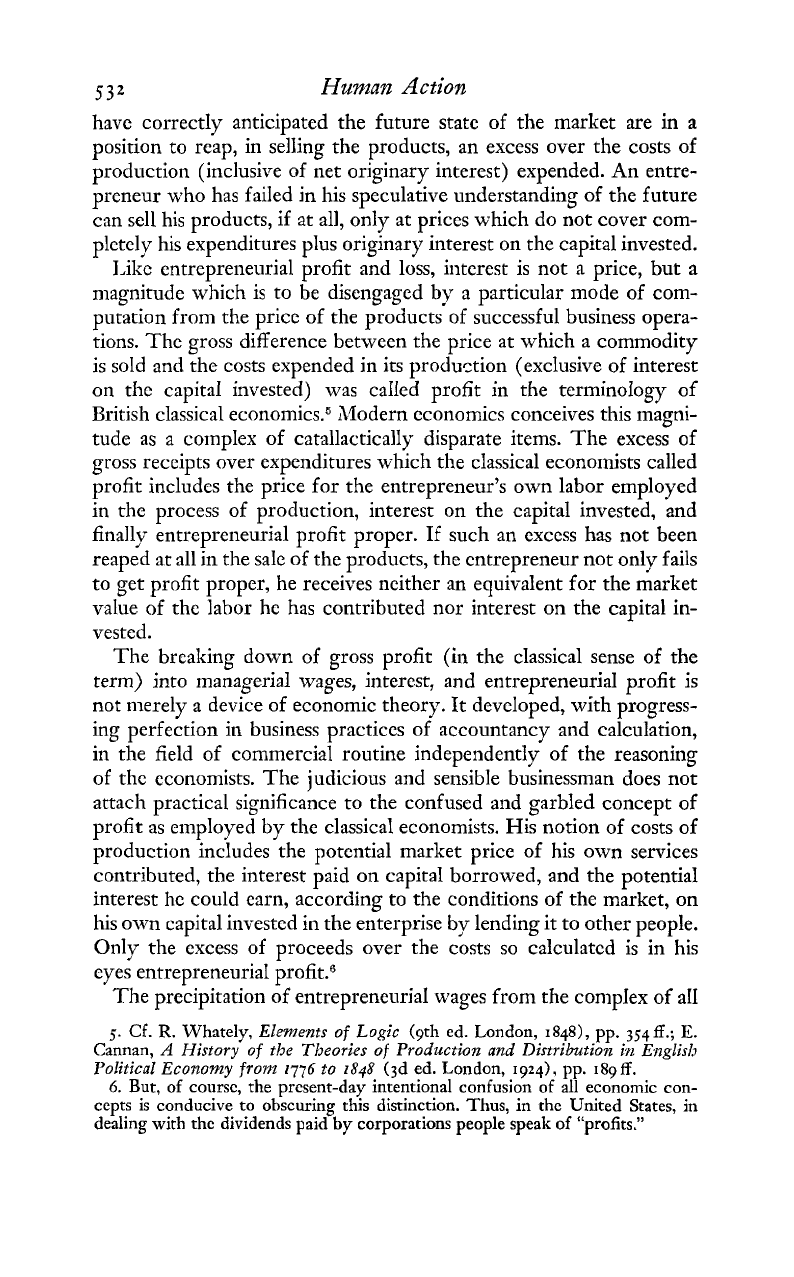
532
Human
Action
have correctly anticipated the future state of the market are
in
a
position to reap, in selling the products, an excess over the costs of
prod~~ction (inclusive of net originary interest) expended. An entre-
prcneur who has failed in his speculative understanding of the future
can sell his products, if at all, only at prices which do not cover com-
pletcly his expenditures plus originary interest on the capital invested.
Like entrepreneurial profit and loss, intcrcst is not a price, but a
magnitude which is to be disengaged by a particular mode of com-
putation from the price of the products of successful business opera-
tions. Thc gross difference between the price at which a commodity
is sold and the costs expended in its production (exclusive of interest
on the capital invested) was called profit in the terminology of
British classical economics."Jodern economics conceives this magni-
tude as a complex of catallactically disparate items. The excess of
gross receipts over expenditures which the classical economists called
profit includes the price for the entrepreneur's own labor employed
in the process of production, interest on the capital invested, and
finally entrepreneurial profit proper.
If
such an excess has not been
reaped at all in the sale of the products, the cntrepreneur not only fails
to get profit proper, he receives neither an equivalent for the market
value of the labor hc has contributed nor interest on the capital in-
vested.
The breaking down of gross profit (in the classical sense of the
term) into managerial wages, interest, and entrepreneurial profit is
not merely a device of economic theory.
It
devcloped, with progress-
ing perfection in business practices of accountancy and calculation,
in the field of commercial routine independently of the reasoning
of the economists. The judicious and sensible businessman does not
attach practical significance to the confused and garbled concept of
profit as employed by the classical economists. His notion of costs of
production includes the potcntial market price of his own services
contributed, the interest paid on capital borrow-ed, and the potential
interest hc could earn, according to the conditions of the market, on
his own capital invested in the enterprise by lending it to other people.
Only the excess of proceeds over the costs so calculated is in his
eyes entrepreneuria1 pr~fit.~
The precipitation of entreprencuria1 wages from the con~pIex of a11
5.
Cf.
R.
Whately,
Elenzents of Logic
(9th ed. London,
18481,
pp.
354ff.;
E.
Cannan,
A
History of
the
Theories of Production and Distribution in English
Political Economy from
1776
to
2848
(3d ed. London,
1924).
pp.
189ff.
6.
But, of course, the present-day intentional confusion
of
all economic con-
cepts is conducive to obscuring this distinction. Thus, in the United States, in
dealing with thc dividends paid
by
corporations people speak of "profits."
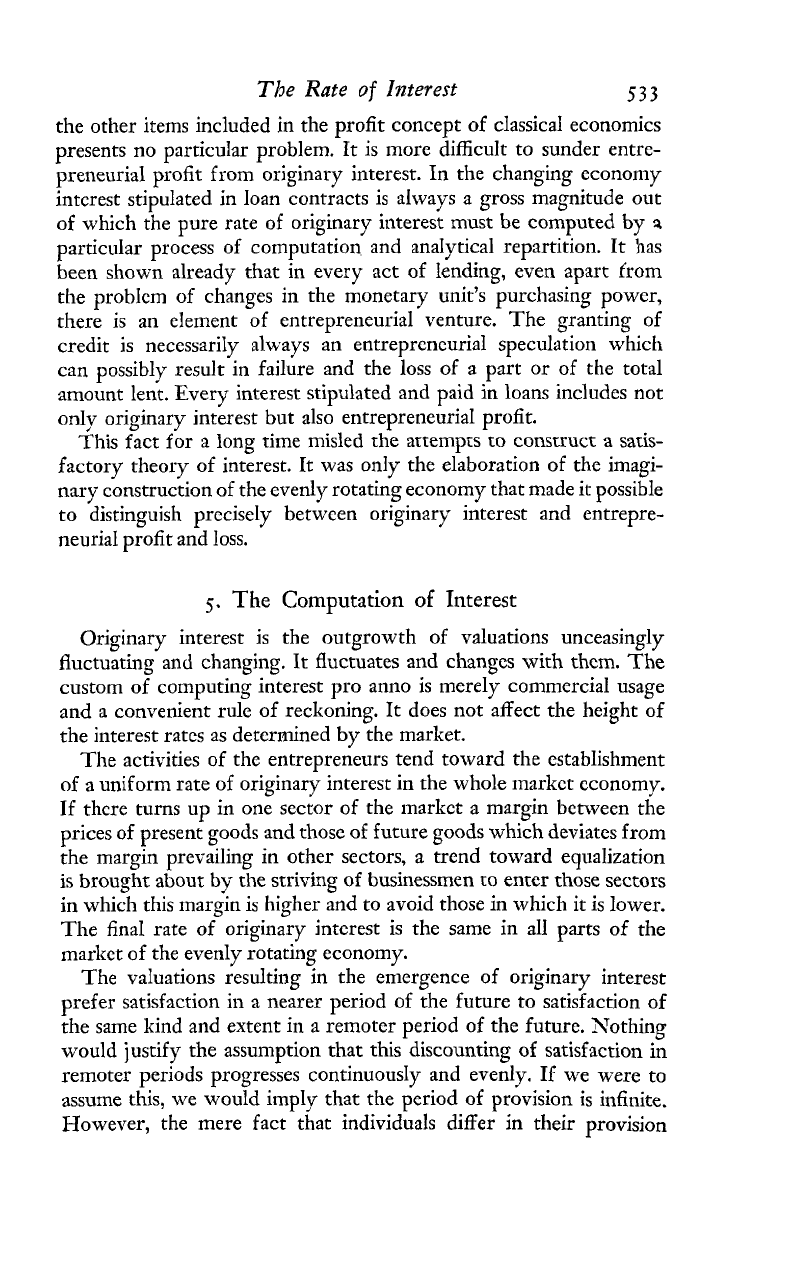
The Rate
of
Interest
533
the other items included in the profit concept of classical economics
presents no particular problem. It is more difficult to sunder entre-
preneurial profit from originary interest. In the changing economy
interest stipulated in loan contracts is always a gross magnitude out
of which the pure rate of originary interest must be computed by
a
particular process of computation and analytical repartition. It has
been shown already that in every act of lending, even apart from
the probIem of changes in the monetary unit's purchasing power,
there is an element of entrepreneurial venture. The granting of
credit is necessarily always an entrepreneurial speculation which
can possibly result in failure and the loss of a part or of the total
amount lent. Every interest stipulated and paid
in
loans includes not
only originary interest but also entrepreneurial profit.
This fact for a long time misled the attempts to construct a satis-
factory theory of interest. It was only the elaboration of the imagi-
nary construction of the evenly rotating economy that made it possible
to distinguish precisely between originary interest and entrepre-
neuriaI profit and loss.
5.
The Computation
of
Interest
Originary interest is the outgrowth of valuations unceasingly
fluctuating and changing. It fluctuates and changes with them. The
custom of computing interest pro anno is merely commercial usage
and
a
convenient rule of reckoning. It does not affect the height of
the interest rates as determined by the market.
The activities of the entrepreneurs tend toward the establishment
of
a
uniform rate of originary interest in the whole market economy.
If there turns up in one sector of the market a margin between the
prices of present goods and those of future goods which deviates from
the margin prevailing in other sectors, a trend toward equalization
is brought about by the striving of businessmen to enter those sectors
in
which this margin is higher and to avoid those in which it is lower.
The finaI rate of originary interest is the same in all parts of the
market of the evenly rotating economy.
The valuations resulting in the emergence of originary interest
prefer satisfaction in
a
nearer period of the future to satisfaction of
the same kind and extent in
a
remoter period of the future. Nothing
would justify the assun~ption that this discounting of satisfaction in
remoter periods progresses continuousIy and evenly.
If
we were to
assume this, we would imply that the period of provision is infinite.
However, the mere fact that individuals differ in their provision
